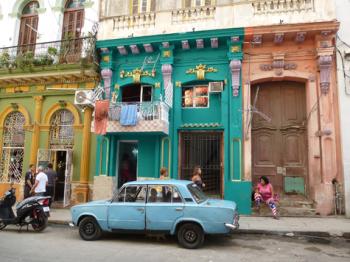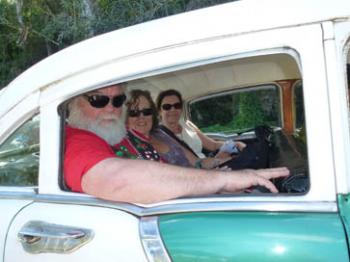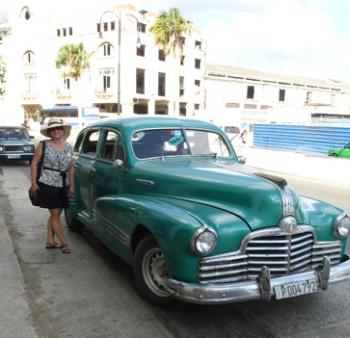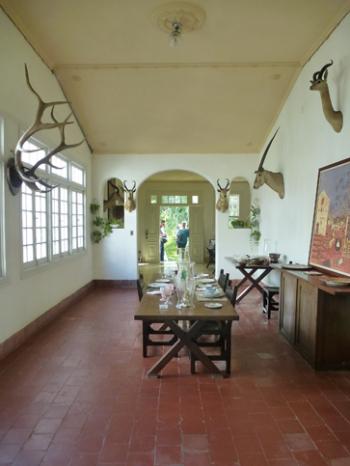Jazz fest and more in Havana
This item appears on page 14 of the February 2017 issue.
I attended Cuba’s 31st Annual Havana International Jazz Festival, which was held in 2015 on Dec. 11-19. Over seven nights, not all of the music was jazz, however, as was evident when my husband, Mark, and I and our friends Linda and Larry Garrett saw Billy Gibbons of ZZ Top perform.
As American citizens not of Cuban descent, our Cuba visit was done through a “People to People” program, specifically, an educational exchange for music. We booked our Cuba package, Dec. 16-22, through a travel agency in the US that I do not want to mention, as I felt they were not very helpful, but there are many companies that will book a package for the annual jazz festival.
For about $2,800 apiece, we got a round-trip charter flight from Tampa, Florida, to Havana; five nights’ accommodation; many meals; our visas; insurance, and an all-inclusive jazz pass.
With our passes, we were allowed to visit seven different venues. The main venue was Teatro Mella, in the Vedado district of Havana. The inside of the theater was nice, with just a couple of rows that had broken seats. It was built to hold 1,500 people, but there were also many more standing when we were there.
The first five to 10 rows of the theater were intended for people who had paid more to sit up front, but other people started sitting in that area and wouldn’t move when asked to. This happened two nights in a row. My advice is don’t buy the better tickets, but get there at least an hour early to find your seats. Don’t sit in the front 10 rows and you should be good.
Also, take your own toilet paper, but tip the poor woman working in the theater’s restroom. There were no toilet seats, no toilet paper, no soap and no flushing. As we exited, the woman and her son came to pour a bucket of water down the toilets. I saw this at several restaurants, clubs and theaters in Havana and even in the airport.
Most nice hotels there did have flushing toilets, however, and provided a limited amount of TP.
We considered ourselves lucky to be staying at Hotel Florida (Calle Obispo esq. a Cuba, Havana; phone +53 7862 4127, www.hotelflorida
havana.com). Our rooms had 18-foot-high ceilings and new toilets, and the security and front-desk help were great. From the hotel, music venues were within walking distance.
It’s not known which acts will be playing at the venues until a month ahead of the festival, and even then it can change. We saw the Preservation Hall Jazz Band from New Orleans. My favorite part was when they invited six older Cuban couples to dance on stage. The band had met them earlier in the week and, oh, those 80-year-olds could cut a rug!
We also watched flamenco dancers. I will always remember the tapping and the beauty of the dancing.
When we showed our jazz pass at the Fábrica de Arte Cubano (Calle 26), we got to cut in front of the very long line. This venue is a cool nightclub with several stages plus works of art. All drinks (water, mojitos, margaritas, colas, beers) cost $2 apiece.
The jazz package was a wonderful way to see Cuba.
•
During our stay in Havana, we hired a driver/guide with a restored, red ’57 Chevy (with a Toyota engine) for six hours. We liked the car when we saw it the previous day, so we asked the driver, Guillermo (phone + 7 831 64 48 or, his cell, 5 368 2575, guillechevrolet
57@gmail.com), if he could drive us the next day.
One place that he took us was José Fuster’s house, and it was a trip highlight. José is an artist who loves to mosaic-tile everything, not only his house and his neighbors’ houses but the whole neighborhood, including the bus stop. The area was a little run-down, but they had art! Make sure to see the artwork in the cultural center across from José’s house.
You can see tons of fabulous artwork at the Almacenes San José Artisans’ Market. Just be sure, if you make a purchase, to get the $3 letter of authentication that’s required to take art out of the country. Officials want to make sure you’re not taking a rare treasure out of Cuba. (All rolled artwork is looked at when you depart the country.)
Guillermo also took us to Hemingway’s home (Finca Vigía), decorated the same way it was in 1961. Hemingway’s boat is there, too, in a museum.
We paid Guillermo a total of about $120. He agreed to pick us up again the following day at 6 a.m. to take us to the airport, but he had to get another driver to help, as we had too much luggage. They were both there on time.
The night before our departure we went out to dinner, then wanted a ride home. Our hostess said no more taxis would come by that night. We asked her to call Guillermo. Though he was busy and couldn’t pick us up, he gave us directions to a hotel four blocks away where there were taxis, and there we caught a cab.
I highly recommend Guillermo for his knowledge, his car, his willingness to help and his smile.
•
On our own, we added a one-day, one-night trip to the Viñales Valley. From Havana, it was 2½ hours each way but well worth it. Our guide there, Fidel, walked us through a tobacco farm, showing us how tobacco is grown, stored and rolled.
We stayed in a casa particular, a private home, with a family that had two little boys. For $35 a night, our accommodations included a bathroom and air-conditioning.
•
Intoxicating but sobering, Cuba is for the seasoned traveler. In this wonderful country located 90 miles from Florida, hotels and music acts often get changed, toilets stop working and hotels run out of food. Soap, toilet paper and medicines can be in short supply.
Air-conditioning is nonexistent in some places. Even in December (their winter season), the temperatures were in the high 80s.
You can’t use American credit cards*, so you’ll need to carry cash. If you exchange American currency, you’ll be taxed 10%.
Most of the cars there are old. When the old Plymouth Belvedere we were in broke down in traffic, we jumped out and four men nearby helped push it to the curb.
I was not expecting the heavy smell of diesel fuel in Havana.
And I wasn’t expecting the absolute joy of the Cuban people, who had more happiness in their hearts than money in their pockets. (The average Cuban makes $25 a month.) The people we met had so much pride in their country.
I also hadn’t expected the grandeur of all the buildings and homes in Cuba nor how beautiful the decaying facades of 60 years of neglect and mildew would look. I was captivated by the lingering ghosts of another time.
Cuba must have been so European and beautiful 60 years ago because it still is beautiful. What an exotic place to visit, one I will never forget!
VICKY HAGAN
Marietta, GA
*See the Travel Brief “Cuba-ready Credit Card,” Aug. ’16, pg. 4.




